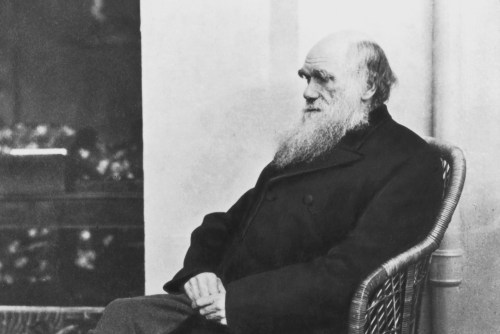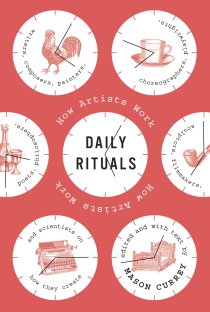Here are the rituals and routines of yet 3 more remarkable people profiled in Mason Currey’s delightful Daily Rituals:
1. Charles Darwin
At the ripe age of 22, Darwin boarded the HMS Beagle and set sail for the Galapagos. At this time, his life was romantic and adventure-filled: he traveled to faraway lands with foreign customs and strange people who spoke in even stranger languages, marveled at the boundless biodiversity of our improbable blue planet, studied his now famous finches and began to formulate his earth-shattering theory of evolution.
However, his life while actually writing On the Origins of Species was rather dull by comparison. To escape the commotion of city life and work without disturbance, Darwin and his family left London in 1842 and moved to the quaint English countryside. There they made their home at Down House, a former parsonage in Kent, about 14 miles southeast of London’s Charing Cross. Darwin loved his secluded home— the “edge of the world” he called it— because he could be alone with his controversial thoughts. He knew his theory of evolution would cause an uproar. Not only did his thesis directly contradict a literal interpretation of the Bible, it suggested that man, who was supposedly created in the image of God, was just another beast in the animal kingdom. Man descended from monkeys? He knew such a blasphemous notion would cause an outcry and potentially ruin his career (time proved Mr. Darwin right; after he published his theory, one critic raged, “Darwin’s story begins in the mud, has a monkey in the middle and an infidel at the tail.”)
Still, Darwin worked steadily in secret on his ideas. At Down House, Darwin led a simple, solitary life. After waking, eating breakfast and taking a morning stroll, the great scientist settled into work. There he labored for an hour and a half before meeting his wife, Emma, in the drawing room, where she’d read him the family letters and a portion of a novel. At 10:30, Darwin returned to his study and worked for another hour and a half, which he considered a good day’s work.
Much like Wordsworth and Thoreau, the father of evolution understood the importance of idleness to creativity and made time for long, meandering walks throughout the day with Polly, his beloved fox terrier. Afternoons were reserved for leisurely lunches with his family and letter writing (Darwin made an effort to respond to every letter he received no matter how nonsensical or crazy); if he didn’t reply to even a single missive, he’d feel so guilty, he couldn’t get to sleep). In the evening, he’d have a small dinner (even if his family was indulging in a luxurious feast, he’d only have tea, an egg or small piece of meat), smoke a cigarette or two, play backgammon with his wife and then read and retire to bed around 10:30.
2. Albert Einstein

Perhaps the most influential scientist of all time, Albert Einstein was many things: groundbreaking physicist, champion of the imagination, unwavering believer in human goodness, unapologetic individualist, passionate pacifist, stanch defender of free speech and civil liberty. In addition to discovering E = mc2 and developing his groundbreaking theory of relativity, he made great contributions to human thought and philosophy.
When Hitler rose to power and the threat of war began to darken the continent in 1933, Einstein fled to the United States where he joined the faculty at Princeton University. There, he followed a predictable routine: he read the papers and ate a breakfast of eggs, mushrooms, and honey, then headed to the office. At 1:30, he returned home for lunch and an afternoon nap. The rest of the day, Einstein worked, answered letters, and occasionally entertained.
Despite his legendary life, Einstein’s day-to-day wasn’t particularly noteworthy. Like most remarkable men throughout history, his life wasn’t glamorous or thrilling, filled with fascinating people, faraway places and glittering parties— it was single-mindedly focused on his work which— from the outside— doesn’t look all that interesting. Picasso could delight in a dinner party now and again, but preferred to paint in his quiet studio in Montparnasse. Matisse worked 7 days a week, only taking a brief respite to oar in the harbor and play violin. When he wasn’t revolutionizing modern poetry, T.S. Eliot was wearing a suit and tie and working a rather regular job at a bank. As philosopher Bertrand Russell once observed so astutely, “Altogether it will be found that a quiet life is characteristic of great men, and that their pleasures have not been of the sort that would look exciting.”
Indeed, Einstein preferred to do certain things the same way everyday to save valuable time and energy. Rather than squander a precious hour debating whether to wear a button down shirt or a cashmere sweater, Einstein bought several versions of the same gray suit so he had a “uniform” he could wear everyday. “The same exact thing…everyday?” you fashionistas may be gasping in horror, “How boring!” Though his unrelentingly gray wardrobe might seem dreary, Einstein understood life was full of decisions: better to automate as many unimportant ones as possible so you can focus on what truly matters: your mission. Steve Jobs and his black turtleneck. Mark Zuckerberg and his uber-casual Silicon Valley uniform of a tee shirt and jeans. If you want to found a multi-billion dollar company or unlock the scientific mysteries of the universe, the idea goes, simplify your wardrobe and streamline your routine.
3. Margaret Mead

Like most productive people from Joyce Carol Oates to Stephen King, cultural anthropologist Margaret Mead was deeply devoted to her work. Endlessly energetic, Mead was always working on something, be it her revolutionary study of adolescence in the South Pacific in her controversy-stirring book Coming of Age in Samoa or her PhD.
Mead’s life is a testament to what positive psychologist Mihaly Csikszentmihalyi discovered in his fascinating study of “flow”: we’re happiest not when we’re relaxing in leisure but when we’re engaged in something difficult and worthwhile. Mrs. Mead despised being unproductive and hated nothing more than frittering away hours. So protective was she of her time that she became enraged at anyone who disrupted her schedule. On one occasion at a symposium, Mead was outraged to learn that a session had been postponed. “How dare they,” she exclaimed, “Do they realize what use I could have made of this time? Do they know that I get up at five o’ clock in the morning to write a thousand words before breakfast? Why did nobody have the politeness to tell me this meeting had been rescheduled?”







